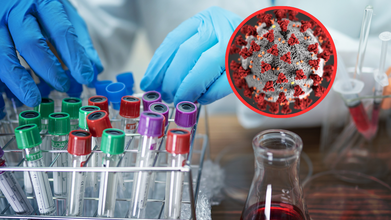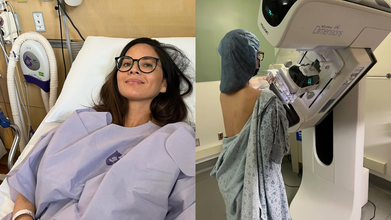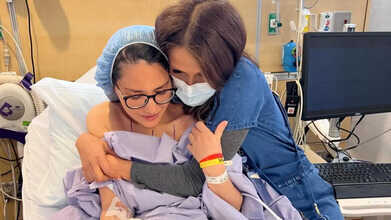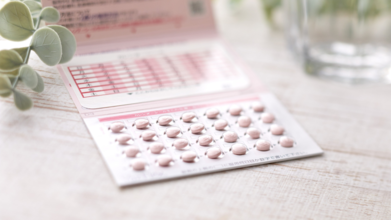- Health Conditions A-Z
- Health & Wellness
- Nutrition
- Fitness
- Health News
- Ayurveda
- Videos
- Medicine A-Z
- Parenting
- Web Stories
Abu Dhabi’s Genetic Screening Programmes For New Borns Could Detect 800+ Diseases

(Credit - Canva)
The Department of Health – Abu Dhabi (DoH) has launched a big initiative to improve healthcare for future generations. Teaming up with the Emirati Genome Council, they've started one of the world's most comprehensive Newborn Genetic Screening Programmes.
Genetic health problems can be difficult to predict and can be passed onto the child, even if the parents did not have symptoms themselves. Many times, these disorders or diseases do not surface until later in life. Here is where genetic screenings and tests come into play. These help us predict any future issues and tackle them head-on.
Instead of treating every patient the same way, this program is designed to deliver a more personal and precise kind of healthcare. It uses advanced genetic technology to look at a person's unique DNA. This allows doctors to catch health conditions much earlier than before, sometimes even before a baby is born.
By finding these issues so early, doctors can provide special, tailored treatments. This means the care a child receives is not a generic plan, but one created specifically for their needs. This approach leads to better results because it gets to the root of the problem right away.
What Is Genetic Screening?
According to National Human Genome Research Institute (NHGRI) It is a process that look at a large group of people to find a smaller group who might be at higher risk for a specific genetic disease. This higher-risk group might either have the disease themselves, be at risk of developing it later, or have a chance of passing it on to their children.
Can We Predict Health Problems?
This program screens for over 815 treatable childhood genetic conditions by looking at a baby's entire genetic makeup, called whole genome sequencing. This makes it one of the most thorough programs of its kind. It's already started at Kanad Hospital and Danat Al Emarat Hospital, where they use advanced technology and Artificial Intelligence (AI) to find conditions that might not be obvious at birth but could become a serious problem later.
The plan is to eventually screen all children of UAE nationals and Emirati mothers born in Abu Dhabi. This is done by collecting a small cord blood sample at birth with the parents' permission. The screening looks for many different issues, including problems with a baby's metabolism, immune system, blood, and rare diseases like Spinal Muscular Atrophy, which can now be treated.
Can Genetic Screening Lead Us Towards Healthy Future?
Parents will get the results within 21 days. If the screening finds anything concerning, a counselor will meet with the family to explain the findings and connect them with specialists for further care.
To make sure the program is a success, the DoH has worked closely with experts. They've held workshops to prepare everyone involved. They also trained 16 pediatricians and neonatologists from Corniche Hospital, Danat Al Emarat, and Kanad Hospital on genetic counseling and why this screening is so important. They also made sure that obstetricians, midwives, nurses, and technical staff at these hospitals were fully prepared.
This program is a key part of Abu Dhabi's bigger goal to use genomics for family health. This includes existing programs like premarital screening. These efforts are all about preventing genetic diseases, helping families make informed decisions, and giving children early access to the care they need. The ultimate aim is to create a healthcare system where personalized, preventative care is the norm, ensuring a healthier future for everyone.
Legionnaires' Outbreak Sickened 108 And Kills 5 In New York City: Can It Spread From Person To Person?

(Credit - Canva)
A recent outbreak of Legionnaires’ disease in Central Harlem, a neighborhood in New York City, has led to a number of illnesses and some deaths. So far, five people have died, and over 100 people have been confirmed to be sick.
The city's health department has been tracking the outbreak since it began in late July. They've found that the number of new cases is going down, which suggests their efforts to clean up the source have been working. Still, they are continuing to investigate and monitor the situation.
The outbreak was traced back to cooling towers in the area. Cooling towers are a part of a building's air conditioning system that uses water to help cool it down. The city health department tested all the cooling towers in the affected areas and found that 12 of them had the bacteria. They have all since been cleaned and treated. Health officials have said that the issue is with the cooling towers, not with the regular hot or cold water in the buildings, and that it's safe for people to continue using their air conditioners.
Can It Spread From Person To Person Contact?
Legionnaires' disease is not contagious, so you can't get it from another person. The disease is mainly spread when someone breathes in tiny water droplets (called aerosols) that are contaminated with the Legionella bacteria.
While it's not common, you can also be exposed by breathing in contaminated soil or, in rare cases, by accidentally breathing in water while drinking it.
Whether a person gets sick after exposure depends on a few things: their overall health, how much of the bacteria is in the air they breathe, and how contaminated the source of the bacteria is.
What Caused The Sudden Surge In Numbers?
As of Monday, 14 people were hospitalized according to the health department. However, within the span of 5 days the number of infections has jumped to 108 people. Harlem City Councilmember Yusef Salaam, in a press conference last week urges people to visit the doctor if they exhibit any flu-like symptom to visit the doctor.
"This is the time for you to actually go and seek medical attention. That's how serious this is."
How Long Does It Take For Legionnaires Symptoms To Appear?
Legionnaires’ disease is a serious type of lung infection, or pneumonia. People can get sick by breathing in tiny water droplets that contain the bacteria. The symptoms can take up to two weeks to appear and often feel like a bad case of the flu, including a cough, fever, chills, headaches, and muscle aches. The disease got its name from an outbreak in 1976 among a group of veterans at a convention. While the disease is not very common, it is becoming more of a concern nationwide, with research suggesting that hotter, more humid weather might be a reason for the increase in cases.
Olivia Munn Breast Cancer Lifetime Risk Assessment Test 2025, Details Inside

(Credit - Oliviamunn/Instagram)
Actress Olivia Munn shared an intimate video from May 2023, just before she had a double mastectomy for breast cancer. The video, posted on Instagram for World Breast Cancer Research Day, shows Munn in her hospital bed with her husband, John Mulaney. He is sitting beside her, holding her hands. They press their foreheads together and speak in hushed tones, surrounded by the quiet sounds of the hospital.
Munn wrote in her caption that this was her first of five surgeries in her "determined battle to beat breast cancer."
One of the biggest aspects of her treatment was the “lifetime risk assessment test” she mentioned in her caption. “Please go to the link in bio to take the quick and free lifetime risk assessment test that saved my life.”

What Is Lifetime Risk Assessment Test?
According to the MagView Tyrer-Cuzick Risk Assessment Calculator* in Munn’s bio, this test helps one calculate their lifetime risk of developing breast cancer. The tool urges people to reach out to their healthcare professional in case they have any questions about their risk of developing breast cancer and what are the best options for breast cancer screenings or genetic counseling they may have.
The US National Cancer Institute also has an Breast Cancer Risk Assessment Tool (BCRAT) known as Gail Model, which helps healthcare professionals estimate a woman’s risk of developing invasive breast cancer over the next five year. The tool uses a person’s medical history as well as breast cancer history among the first-degree relatives to estimate theur risk of getting breast cancer
Olivia Munn’s Breast Cancer Journey
In her post caption, Munn details how she has gone through a double mastectomy, reconstruction surgery, a lymph node dissection, and a hysterectomy. She recently shared that her mother also received a breast cancer diagnosis two years after her own.
Munn explained that both her and her mother's cancer are "very aggressive, fast-moving." However, she added that thanks to research funding, they both had a path to survival. For example, she said that endocrine therapy, a hormone treatment she is currently on, was discovered just 20 years ago. This treatment works by keeping hormones from reaching cancer cells.
Also Read: World Mosquito Day 2025: Dengue Transmission Isn’t One-Way, Humans Infect Mosquitoes Too
Olivia Munn’s Message for Early Detection of Breast Cancer
Munn emphasized that funding for breast cancer research has created treatment plans that give her and many others hope. She urged her followers to donate, saying that their contributions could save countless lives by helping to find cures and improve treatments. She also recommended supporting organizations like Susan G. Komen and the American Cancer Society, which have made a real impact.
In her post, Munn also encouraged women to take the breast cancer assessment test. She discovered she had a 37% chance of breast cancer, which led to more tests that found her aggressive form of the disease. She stressed that any woman over 30 should take the test, and if their risk is above 20%, they should ask their doctor for a breast MRI.
Who Should Get Breast Cancer Screening Done?
According to the American Cancer Society, you are considered to be at average risk if you do not have a personal history of breast cancer, a strong family history of it, or a known genetic mutation (like in the BRCA gene) that increases your risk. This also applies if you have not had chest radiation before the age of 30. These are the breast cancer screening recommendations for women who are average risk.
Ages 40-44: You have the choice to start getting a mammogram every year.
Ages 45-54: You should get a mammogram every year.
Ages 55 and older: You can switch to getting a mammogram every other year, or you can choose to continue getting one every year. You should continue to get screened as long as you are in good health and are expected to live at least 10 more years.
Keep in mind that these guidelines are for mammograms only. Clinical breast exams, which are physical exams done by a doctor or other healthcare professional, are not recommended for breast cancer screening in women at average risk.
*Please Note: The Magview Tyrer-Cuzick Risk Assessment Calculator is for non-commercial and non-clinical use, for a clinical diagnosis, please reach out to your healthcare professional.
US Women Are Now Ditching The Prescription For The First Over-the-Counter Birth Control

Credits: Canva
Two years after the United States approved its first over-the-counter (OTC) birth control pill, new research shows that the medication is being widely used by people who previously struggled to access contraception.
The findings, published Monday in JAMA Network Open, offer one of the earliest looks at how the pill, known as Opill has reshaped reproductive health choices.
Who All Are Turning to OTC Contraception
The study included 986 people between the ages of 15 and 45, living across 44 states. All participants had obtained Opill either online or at a local pharmacy.
Researchers found a significant shift in contraceptive use among these individuals. Many had previously relied on less effective birth control methods, such as condoms or emergency contraception, while others had used no birth control at all.
The data showed a 31.8% point increase in contraceptive use among those who had previously used no birth control and a 41% point increase among those who switched from less effective options.
“This is one of the first studies to show that over-the-counter birth control pills are reaching the very people they’re meant to help, those who face the greatest barriers to care,” said lead author Dr. Maria Rodriguez, a professor of obstetrics and gynecology at Oregon Health & Science University in Portland.
Who Benefits Most? Younger, Rural, and Uninsured Populations
The research found that people opting for OTC birth control were more likely to be uninsured, live in rural areas, and be in the younger age in the bracket of 15 to 20 years old.
The top reason participants gave for choosing Opill was convenience: it did not require a doctor’s appointment. For many, that was critical, as some did not have a regular physician at all.
“At a time when pregnancy is becoming even more dangerous in the United States, especially for people of color, those with low incomes and those living in rural communities, our findings underscore that OTC contraception is a powerful tool for reproductive autonomy,” Rodriguez said in a news release.
Why the FDA Approved Opill
Opill, manufactured by Perrigo, is a progestin-only pill that became the first daily contraceptive in the U.S. available without a prescription when the Food and Drug Administration approved it in 2023.
At the time, the FDA emphasized the move’s potential to expand access, noting that nearly half of the 6.1 million pregnancies in the U.S. each year are unintended. Public health experts argued that making birth control available without prescription could help reduce those numbers and provide more autonomy to individuals who face systemic barriers in health care.
Outside Experts See Major Public Health Implications
The study’s findings drew attention from other health experts, who agreed that the shift could have far-reaching consequences.
“While greater access to contraception without prescriptions can be life-changing for women with limited resources, it also highlights how deeply the repercussions of unplanned pregnancies still ripple through health care systems and communities,” said Dr. Jessica Shepherd, a board-certified OB/GYN and chief medical officer of the online health company Hers, in an interview with CBS News.
Unplanned pregnancies, she noted, are often associated with higher maternal and infant health risks, financial strain, and long-term socioeconomic challenges. Those burdens, Shepherd added, fall most heavily on women already navigating barriers to care.
READ MORE: How Abortion Policies Have Changed Across States Since Dobbs Ruling?
A Step Toward Greater Reproductive Autonomy
For now, experts say the early data is promising and demonstrates that Opill is fulfilling its intended role: reaching those who need reliable contraception the most.
As debates over reproductive rights continue across the U.S., researchers say the success of Opill could also pave the way for additional contraceptive methods to be made available without a prescription, expanding access even further.
© 2024 Bennett, Coleman & Company Limited

